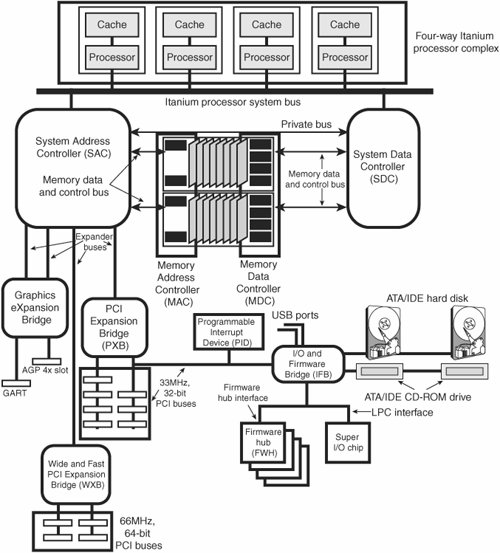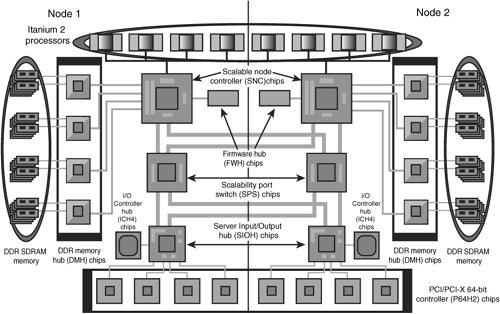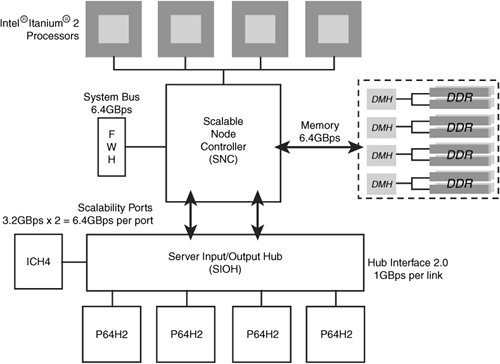Intel Itanium and Itanium 2 Chipsets
| Intel's first 64-bit server processors are the Itanium and Itanium 2 processor families. The 64-bit architecture of these processors is a completely different architecture than the 32-bit or x64 extensions to 32-bit processor architectures supported by the Intel Pentium series and AMD Athlon series. (See Chapter 2 for more information.) Intel's first chipset for the Itanium, the 460GX, was introduced in June 2001, coinciding with the initial release of the Itanium processor. The 460GX chipset included 10 components, enabling developers to customize Itanium systems for use as workstations with AGP4x graphics or as servers with up to four Itanium processors. The original Itanium was quickly replaced by the Itanium 2 because the Itanium's lengthy development time basically made it obsolete by the time it was delivered. The Itanium 2 offers faster clock speeds and larger memory caches than the original Itanium. The current Intel Itanium 2 chipset is the E8870, which supports up to four Itanium 2 processors. When equipped with the E8870SP scalability port switch component, the E8870 supports up to eight Itanium 2 processors. The E8870 was introduced in August 2002. The following sections provide detailed information about these chipsets. The Intel 460GX Chipset for ItaniumThe Intel 460GX chipset, the first (and only) chipset developed by Intel for the first-generation Itanium processor, was scarcely a chipset in the established sense of the term. Instead of using a relatively small number of versatile chips, the Intel 460GX seemed to use a different chip for almost every significant task performed outside the processor. As a result, the 460GX chipset includes a total of 10 components:
Figure 3.21 illustrates the architecture of a four-way system using the 460GX chipset. Figure 3.21. The 460GX used many single-purpose chips instead of highly integrated chips to support the original Itanium processor. Very few servers were built using the Itanium processor or the 460GX chipset. However, the 460GX chipset is significant for being the most complex Intel chipset to date. The Intel E8870 Chipset for Itanium 2The Itanium 2 processor rapidly replaced the original Itanium processor, and because of major changes in its design, a brand-new chipset was needed. The E8870 was introduced at the same time as the Itanium 2, and it continues to be Intel's only Itanium 2compatible chipset. (Other vendors have also produced Itanium 2 chipsets.) Note The E8870 was designed during the period in which Intel had selected RDRAM as its preferred memory technology. However, by the time the E8870 was introduced, it had become obvious that RDRAM was more expensive than DDR SDRAM and did not offer performance commensurate with its higher cost. Thus, Intel decided to add a DDR memory hub component to the E8870 to convert DDR SDRAM signals to RDRAM signals compatible with the SNC's built-in memory controller. While this adds several chips to typical E8870 implementations, servers based on the E8870 can now use reasonably priced registered DDR SDRAM instead of expensive RDRAM. Unlike the 460GX, the E8870 (also known as the 870) uses Intel's modern hub architecture along with specialized support chips. The E8870's components include the following:
These components are used in four-way Itanium implementations; each four-way implementation is known as a node. However, an additional component, known as the E8870SP, the Scalability Port Switch (SPS), is used to connect two nodes into an eight-way implementation. The SPS was introduced after the initial release of the E8870 chipset. Figure 3.22 illustrates the architecture of a typical four-way Itanium 2 system using the E8870, and Figure 3.23 illustrates how the SPS is used to enable eight-way processing. Figure 3.22. The E8870's architecture in a typical four-way implementation. Figure 3.23. The E8870's architecture when SPS chips are used to create a two-node (eight-way) system. Note that one SPS chip is used for each node. |
EAN: 2147483647
Pages: 240
